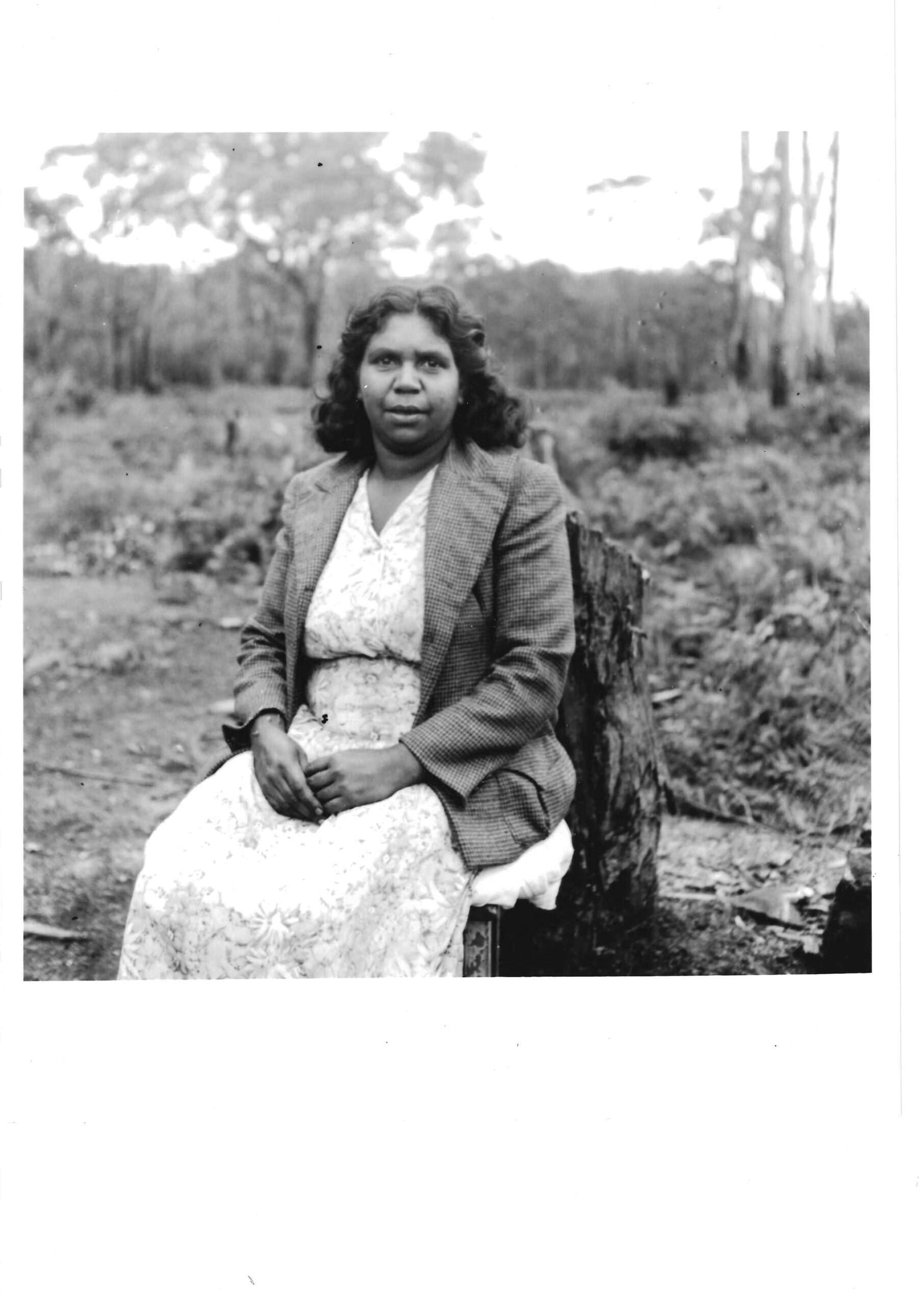Euphemia Mullett

Euphemia Cora Mullett /Tonkin nee Hood (known as Euphie)
Born 21st February 1927, Lake Tyers Mission; Died 5th August 1997 Orbost
“It’s a white man’s world- we have to live in it.” Euphemia Mullett
Dorothy Hood’s daughter Euphemia Mullet came from Lake Tyers Mission to Jackson’s Track.
Imagine living in an institution of government-owned buildings where every element of her life was controlled by others, then moving to an out-of-sight bush place with bark huts beside a running creek, with the freedom to pretty-much do as you pleased and with friends and family around. It must have been joyous.
Euphie settled with Darryl Tonkin[1] and was mother to 13 children; 11 were Darryl’s. Like her mother Dora, Euphie insisted on cleanliness, physical health, Traditional Culture and education as the ways to survive in their divided world. Constantly bubbling over the outdoor fire, the half 44-gallon drum of water demonstrated Euphie’s insistence on daily clothes-washing and hut scrubbing.
Euphie was the acknowledged genealogist within the community, with a vast knowledge of where people came from, who they were related to. She kept alive the cultural understandings of blood lines and kin/skin, repeating often, “Get your education but don’t forget your culture.”
Euphie dealt with racism all her life and was even abducted from Jackson’s Track by her white partner’s family (Tonkin) because they were so ferociously opposed to the relationship.
The matter of a white man living with a black woman was considered disgraceful and in some states was illegal. About a week later, Euphie got word to Darryl: “Dear Darryl, Harry dumped me near Orbost. I’m at a sleeper-cutters’ camp … at Newmerella … I am waiting for you to come and get me.”
Across the years, in the hospitals where Euphie gave birth to her children, the Aboriginal women were separated from the white women.
Euphemia’s children and grandchildren are currently Kurnai Elders in West Gippsland and First Nations advocates in fields of Aboriginal Affairs, education, health and welfare organisations.
This Biography was written by Jeannie Haughton in consultation with Aunty Cheryl Drayton – Kurnai Matriarch and descendant of Euphemia Mullett
Photograph: Euphemia Mullet – Jacksons Track supplied by daughter Aunty Cheryl Drayton
Film: Jackson’s Track — CheekyMac Productions
Commemoration: Three Kurnai Women
Three Kurnai Women is a life-size bronze sculpture celebrating the leadership of three Kurnai women. This significant public artwork, unveiled on May 27 – Reconciliation Week 2023 stands proudly on Kurnai Country in Drouin’s Civic Park.
Three Kurnai Women is the first artwork in the area solely dedicated to honouring First Nations women and pays homage to Dorothy Hood, Regina Rose, and Euphemia Mullet, who displayed leadership, wisdom, tenacity and cultural integrity to protect their families, wider community, and their Kurnai Culture in the face of historic and racial discrimination.
Each woman holds an object: a book, a laundry tub, a guitar. Selected by Kurnai Elder Cheryl Drayton – Euphemia Mullet Tonkin’s daughter – these objects represent the struggles they faced as Aboriginal people and the constant endeavor of keeping their families safe and together. The artwork depicts the three women intertwined, anchored to country and to each other.
Three Kurnai Women is a shining example of female artists working together to bring sculptures of women and their stories into public places. The sculpture was designed by local artists Jessie McLennan and Rebecca Vandyk-Hamilton, working in close consultation with Kurnai Elder Cheryl Drayton. They prepared the concept designs, sketches and clay maquettes. Meridian Sculpture foundry in Melbourne then created a full-size 3D model.
Lynette (Grace) Hayes, Regina Rose’s daughter, created the frieze border for the artwork which incorporates Kurnai symbols such as the blue wren.The piece is accompanied by oral recordings and written historical storytelling by Kurnai Elder Cheryl Drayton and local writer Jeannie Haughton.The stories can be accessed by scanning Finding Her QR codes at the base of the sculpture and by visiting the stories of Drouin website.
Three Kurnai Women was proudly supported by the Victorian Government’s Victorian Women’s Public Art Program and by Baw Baw Shire Council This significant public artwork stands to remind local residents and visitors of the very recent history of the First Nations’ families who lived and worked for decades at Jackson’s Track in Labertouche, until they were forcibly relocated to Drouin.
Site: Civic Park Drouin
Drouin Civic Park is a picturesque park located in the centre of town. The Three Kurnai Women sculpture has pride of place, signifying a physical place and prompt to discover the stories and incredible contributions of First Nations Women on Jackson’s track.
This family friendly site also includes a playground, a skate park, a small lake, shelters, cycle and pedestrian trail and car parking. This park is easily accessible by public transport.
[1] Jackson’s Track: Memory of a Dreamtime Place

